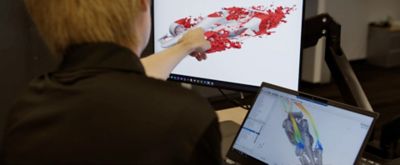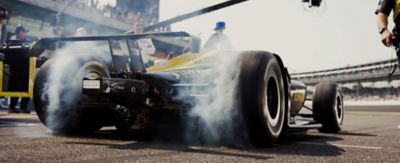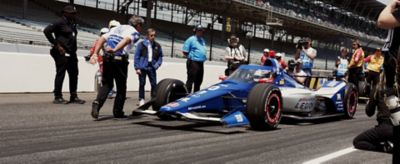-
United States -
United Kingdom -
India -
France -
Deutschland -
Italia -
日本 -
대한민국 -
中国 -
台灣
-
-
產品系列
查看所有產品Ansys致力於為當今的學生打下成功的基礎,通過向學生提供免費的模擬工程軟體。
-
ANSYS BLOG
February 22, 2024
How Simulation Drives Honda Racing Corporation’s Need for Speed at the Indy 500
For the HRC, it’s all about winning. Tune in to Episode 7 of “Driven by Simulation” to hear how Ansys is helping the racing icon prepare for victory at the Indy 500.
Last year, some 300,000-plus fans gathered to watch an annual automotive event that flexes on prestige, power, and performance. Undeniably the most recognizable race in the history of motorsport, the Indianapolis 500 has been characterized as a mix of the technology of a SpaceX rocket launch with the tradition of baseball at 220 mph.
IndyCar racing series’ premier event has evolved since its inception in 1909, from a test bed for vehicle performance to a 500-mile racing spectacle steeped in tradition. Still, not everything can be relegated to its storied past. Indy performance today is largely driven by cutting-edge technologies like simulation.
Honda Racing Corporation (HRC US, formerly known as Honda Performance Development) can certainly attest to that. The 15-time Indy 500 champion is relying on Ansys software to gear up for 2024 and reclaim victory at the podium over a celebratory slug of milk.
Racing through Development with Simulation
If you know anything about IndyCar, you may be wondering why simulation is used at all. After all, the Indy 500 is part of a spec series, meaning every car that competes on the track shares the same chassis requirements. While these designs may be fully baked, behind the scenes there’s still much work to be done before race day 2024. That’s because winning often comes down to just a few small adjustments.

Ryder Liu, lead CFD engineer, aerodynamics at Honda Racing Corporation, points out how Ansys simulations help the team fine-tune aerodynamics.
“So, everything you see on the Indy car, everything the air flows over, we’re responsible for getting information to our teams, and really understanding it to make the best decision possible,” says Jonathan Seaman, aerodynamics group lead, HRC US. “When you’re on the track, the boundary conditions change so much. The temperature changes, the wind changes. When the track temperature changes the tire responds differently. So, for us it’s really trying to use simulation to understand all these different variables, but also control the variables too, which simulation does very well.”
For the Honda Racing team, aerodynamics are a critical part of vehicle development. The team uses a virtual simulation environment and wind tunnel testing with a full-size car to assess the air flow around it. This ensures the car will be stable during cornering, braking, and acceleration at top speeds.
While only so many hours are allotted to teams who arrange to test in a wind tunnel, simulation is not limited by time or space. There are very few facilities in proximity of an Indy team using full-size cars for aerodynamic testing, which can make analysis prohibitively expensive and inconvenient for any team.

The race to conquer airflow is also compounded by the addition of new parts released in recent years to reduce the amount of dirty air generated by the lead car during a race that can reduce grip on the track. Simulation can account for and assess these changes quickly, and zero-in on any adjustments that need to be made before further physical testing.
Honda offsets the need for extensive, expensive wind tunnel testing with computational fluid dynamics (CFD) to save resources and time during development. Accessing Ansys Fluent fluid simulation software in Ansys Cloud Direct, the team can run massively large simulations involving millions of cells using all of the CPU processors needed for comprehensive CFD analysis.
And it’s Big Data for the Win
All of this virtual testing in the cloud results in enormous amounts of simulation data, which can be generated quickly, then immediately analyzed anytime, anywhere — in the office or the garage, on the track, or for comparative analysis during wind tunnel testing that leads to validation. Here, the key benefit of simulation is the ability to iterate and test incredibly quickly. Simulating different variables is virtually limitless when compared to physical prototyping and testing, which leads to improvements in other aspects of a car that might otherwise be overlooked, saving the team time and cost.
“(Simulation) is a great tool for us, it allows us to iterate very quickly, and try to do a lot of stuff that maybe we wouldn’t even try to do before,” says Ryder Liu, lead CFD engineer, aerodynamics at Honda Racing Corporation. “… We can’t run an engine in the wind tunnel, we can’t have a hot system to create heat to see how it cools, but this is something that we can do in CFD. Especially at Indy 500 where the speeds can get up to 240 miles per hour on the straightaways and 230 in the corners, any performance advantage in drag, aerodynamic downforce, any cooling advantages, even things like driver feel … in all those scenarios can make a difference. And we have hundreds of people working here to make that happen.”

Honda Driver Katherine Legge
Ansys Helps Honda Drivers Go with the Flow
A multimillion-dollar, ultra-realistic racing simulation is also helping drivers understand on-track interactions during a race. Honda worked with hardware providers and Ansys to provide a pack simulation of the Indy 500 involving multiple cars — the largest simulation the organization has run to date that is currently being used by its active IndyCar drivers throughout the season.
“How do you drive at high speed when near upper cars?” asks Liu. “There's a lot of talk in motorsport about the dirty air and … how when you're behind a car, your aerodynamics become worse, you lose, your drag goes down, but also your downforce goes down (which) makes the car harder to handle. Providing our drivers with simulation information to tell them this is where you should drive if you want to set up a pass on someone is incredibly valuable.”

Honda Racing driver Alex Palou leaving the pit
Of course, there’s more to see! Tune in to Episode 7 of Ansys online docuseries “Driven by Simulation.” You’ll hear from drivers Alex Palou and Katherine Legge, along with the rest of the Honda Racing team as they share how simulation is part of their winning strategy at Indy.











